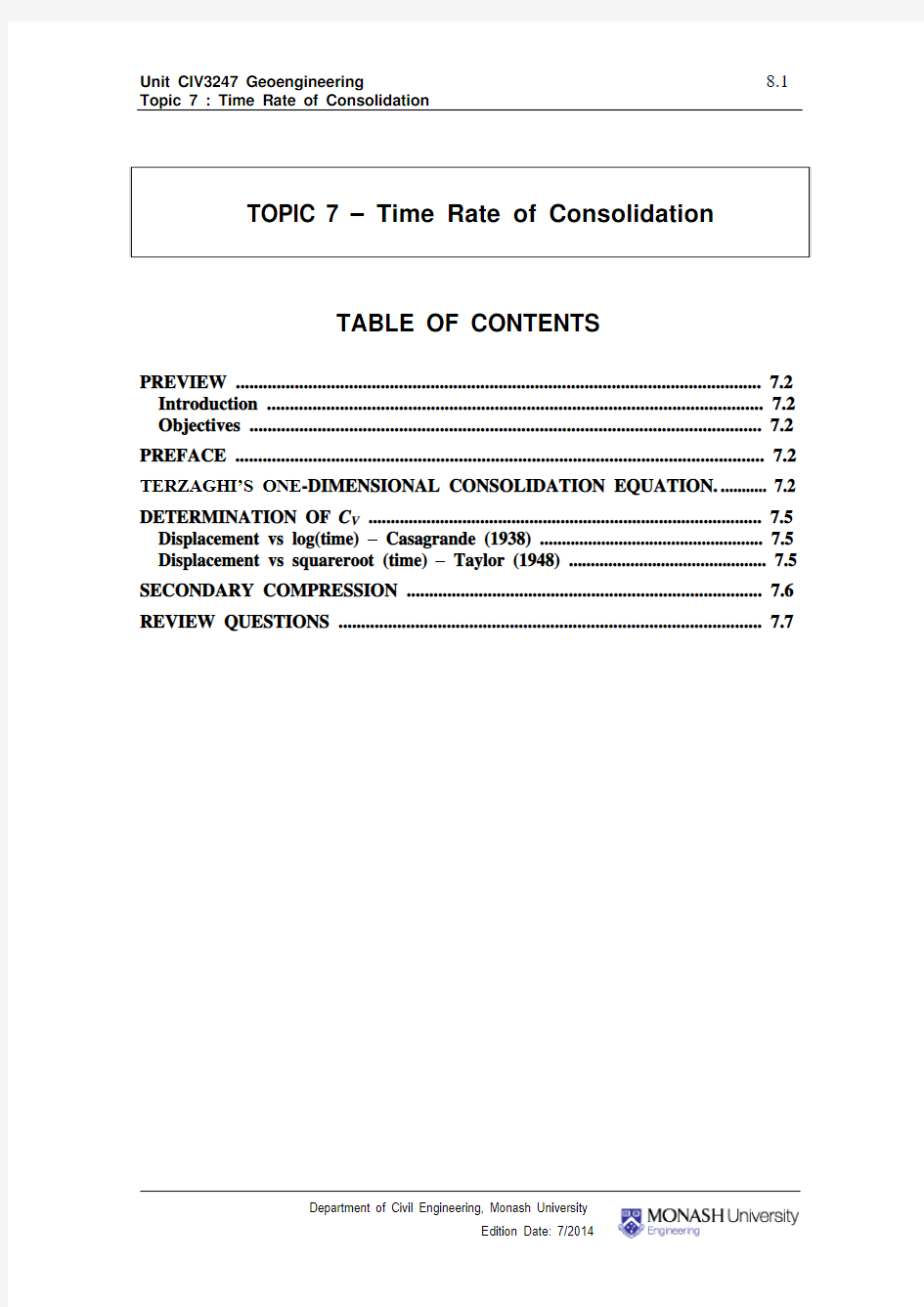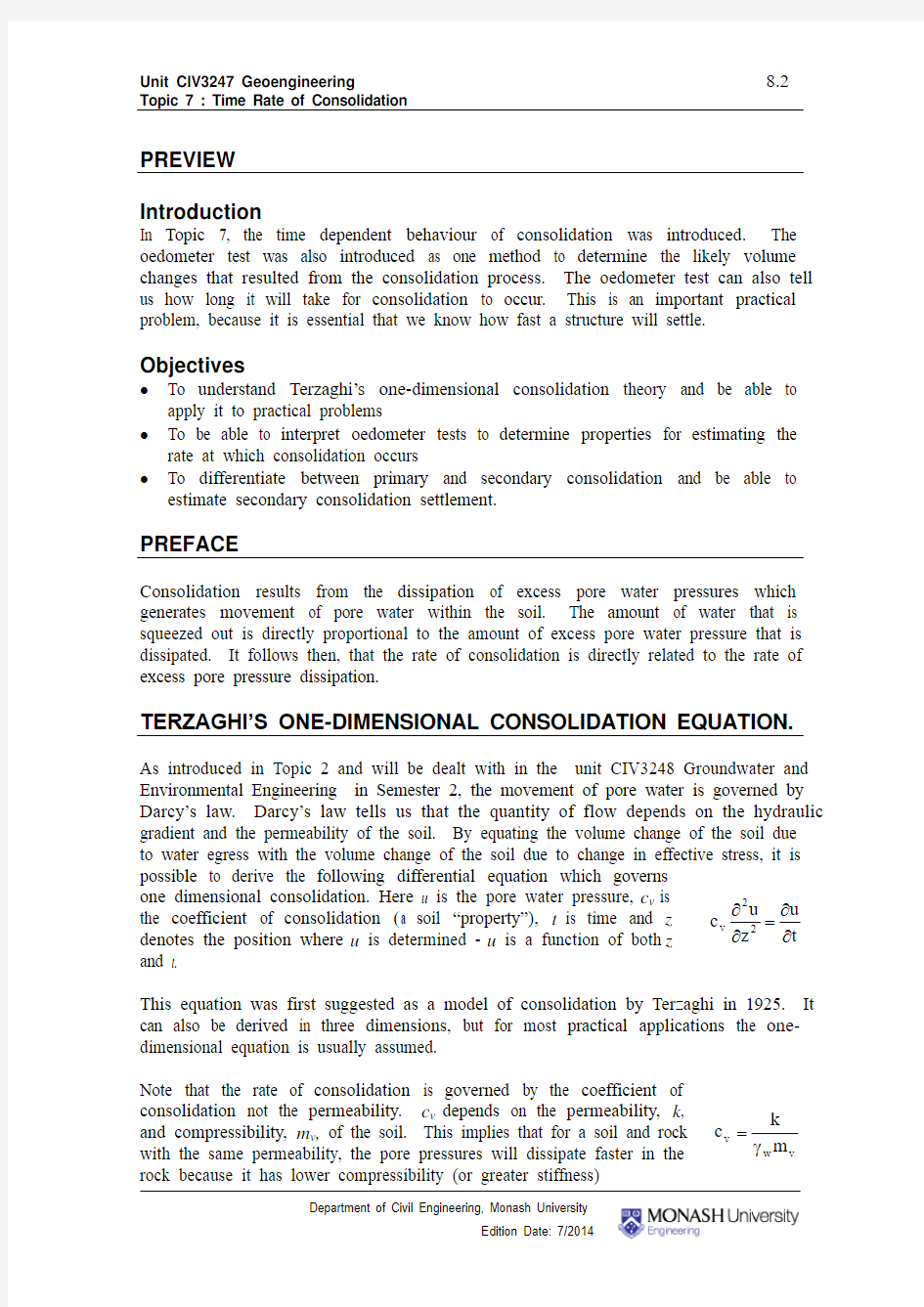Topic7 -Time+rate+of+consolidation


TABLE OF CONTENTS
PREVIEW .................................................................................................................... 7.2 Introduction ............................................................................................................. 7.2 Objectives ................................................................................................................. 7.2
PREFACE .................................................................................................................... 7.2
TERZAGHI’S ONE-DIMENSIONAL CONSOLIDATION EQUATION. ........... 7.2
DETERMINATION OF C V ........................................................................................ 7.5 Displacement vs log(time) – Casagrande (1938) ................................................... 7.5 Displacement vs squareroot (time) – Taylor (1948) ............................................. 7.5
SECONDARY COMPRESSION ............................................................................... 7.6
REVIEW QUESTIONS .............................................................................................. 7.7
PREVIEW
Introduction
In Topic 7, the time dependent behaviour of consolidation was introduced. The oedometer test was also introduced as one method to determine the likely volume changes that resulted from the consolidation process. The oedometer test can also tell us how long it will take for consolidation to occur. This is an important practical problem, because it is essential that we know how fast a structure will settle. Objectives
?To understand Terzaghi’s one-dimensional consolidation theory and be able to apply it to practical problems
?To be able to interpret oedometer tests to determine properties for estimating the rate at which consolidation occurs
?To differentiate between primary and secondary consolidation and be able to estimate secondary consolidation settlement.
PREFACE
Consolidation results from the dissipation of excess pore water pressures which generates movement of pore water within the soil. The amount of water that is squeezed out is directly proportional to the amount of excess pore water pressure that is dissipated. It follows then, that the rate of consolidation is directly related to the rate of excess pore pressure dissipation.
TERZAGHI’S ONE-DIMENSIONAL CONSOLIDATION EQUATION. As introduced in Topic 2 and will be dealt with in the unit CIV3248 Groundwater and Environmental Engineering in Semester 2, the movement of pore water is governed by Darcy’s law. Darcy’s law tells us that the quantity of flow depends on the hydraulic gradient and the permeability of the soil. By equating the volume change of the soil due to water egress with the volume change of the soil due to change in effective stress, it is possible to derive the following differential equation which governs
one dimensional consolidation. Here u is the pore water pressure, c v is
the coefficient of consolidation (a soil “property”), t is time and z
denotes the position where u is determined - u is a function of both z
and t.
This equation was first suggested as a model of consolidation by Terzaghi in 1925. It can also be derived in three dimensions, but for most practical applications the one-dimensional equation is usually assumed.
Note that the rate of consolidation is governed by the coefficient of consolidation not the permeability. c v depends on the permeability, k,
and compressibility, m v, of the soil. This implies that for a soil and rock
with the same permeability, the pore pressures will dissipate faster in the rock because it has lower compressibility (or greater stiffness)
v
w
v m
k c
γ
=
t
u
z
u
c
2
2
v?
?
=
?
?
Terzaghi’s consolidation equation can be solved using analytical or nume rical
techniques. The solution obtained depends on the boundary conditions. For the oedometer test, with a sample of height, 2H, the boundary conditions are :
1. Complete drainage at top and bottom of sample; i.e. u = 0 at z = 0 and z = 2H
2. The initial excess pore water pressure ?u = u I is equal to the applied stress increment ?σ; i.e. when t = 0, ?u = u I = ?σ = (σ'2-σ'1).
Note the length of the longest drainage path is half the sample height, H , since drainage can occur to both the top and bottom of the sample.
The solution is obtained as a Fourier series which can be conveniently expressed in the following form :
Where U z is the degree of consolidation at time t at depth z, and T is a non-dimensional time factor. U z and T are given by :
where H dr is the length of the longest drainage path. The solution is shown graphically in Figure 1.
Figure 1 : Time rate of consolidation curves for two way drainage
This diagram can be used to determine the degree of consolidation throughout the layer. For example, the degree of consolidation, U z , at mid height of an oedometer test for T=0.2 (Point A) is approximately 23%. However at the same time (and time factor) at other locations, U z is different. At z/H=0.5, U z = 44% and at z/H=0.1, U z = 86%.
C o n s o l i d a t i o n r a t i o , U z
()
T f H z f 1U 20n 1z ∑∞
=??
?
??-=i 1
21211z u u
1e e e e U -
=σ'-σ'σ'-σ'=--=
2dr
v
H t
c T =
Note that other boundary conditions have different solutions. These can be obtained from most reference books that deal with consolidation.
In most settlement calculations we are interested in the average degree of consolidation of the entire layer rather than the point values given above. This can be calculated by finding the area under the appropriate T curve in the above diagram. For problems in which initial excess pore pressure is constant throughout the consolidating layer, the following values apply.
Some useful approximations (Cassagrande, 1938; Taylor, 1948) are:
U av > 60% T = 1.78 - 0.933log(100-U av %)
2
2100%44
%60??
?
??=
=
av U U T U ππ In terms of settlements : where s(t) is the settlement at any time, t , and s c is the total primary consolidation settlement at t 100. c av s )t (s U = DETERMINATION OF C V The coefficient of consolidation can be determined from the oedometer displacement and time data or from the consolidation phase of a triaxial test. Only the oedometer test will be dealt with. The displacement and time data need to be plotted in the form of displacement vs square root (time) or displacement vs log(time). Displacement vs log(time) – Casagrande (1938) 1.Determine end of primary consolidation t p (or t100) and d100 by plotting tangents to curve- see below. 2.Determine true origin of test; i.e. d0 and t0 by the following process : Choose any two times t1 and t2 where t2= 4 t1. Determine d2-d1, the settlement increment over the period t2-t1. d0 is located distance d2-d1 above d1. 3.d50 (or U=50%) is located midway between d0and d100 . t50 can be read directly of the log(time) axis. 4.Determine c v from 2 dr 50 2 dr v H T T H c= = line back to zero time to establish d 0. 2. Draw second line from d 0 with abscissas 1.15 times larger than that of the first line. 3. The intersection of this second line and the laboratory curve defines d 90 and t 90. 4. Determine c v from Note : 1. c v determined from root time method is usually slightly greater than that determined from the log time method. 2. c v is not constant, but depends on stress level. 3. For pressures less than the preconsolidation pressure, consolidation occurs quite rapidly, and c v can be relatively high. However, interpretation can be quite difficult, as the displacement time graphs do not have the “classical” shapes shown earlier. Typical values of c v for soft clays range from 0.1 to 0.5 m 2/year and gradually increase with OCR. Due to soil fabric, roots, small sample size, etc; c v measured in the laboratory tend to be less than those measured in the field. SECONDARY COMPRESSION Secondary compression or creep occurs at a much slower rate than primary consolidation and differs from primary consolidation in that it occurs at a constant effective stress. Nevertheless, creep settlements can be very large. One method of estimating creep settlement is through the secondary compression index C α. 90 2dr 902dr v t H T t T H c = =t e C log ??= α where ?e is the change in void ratio between times t a and t b , and ?log t =log t b - log t a . C α is usually estimated over one log cycle of time; e.g. from t a = 100 to t b =1000 (or from 1000 to 10000 etc), then ?log t = 1 and C α = ?e . See Figure 2. The modified secondary compression index , C αε, , giving strain rather than void ratio change, can also be defined as Where e p is the void ratio at the start of the linear portion of the e vs log t curve. (e 0 is often used with little loss of accuracy). Both C α and C αε can be determined from the slope of the straight line portion of the displacement vs log(time) curve following the end of primary consolidation. Typical values of C α /C c : organic soft clays : 0.05 +/- 0.1 inorganic soft clays : 0.04 +/- 0.1 sands : 0.015 – 0.03 REVIEW QUESTIONS 1. Which properties of a soil govern the rate at which excess pore water pressures dissipate ? 2. For the following construction activities, plot on the same graph the expected variation of pore water pressure (on the vertical axis) with time (on the horizontal axis) for a point in the soil immediately beneath the construction activity. Assume that the initial pore water pressure is the same in all cases and that all activities cause the same local magnitude change in pore water of ?u. ?u can be positive or negative depending on the activity. (a) Addition of extensive fill overlying a deep deposit of clay (b) Addition of extensive fill overlying a deep deposit of sand (c) Addition of extensive fill overlying a shallow layer of clay overlying sand (d) Footing on deep deposit of clay (e) Excavation in deep deposit of clay p e C C +=1α αε (f)Lowering of ground water table in clay (g)Raising of ground water table in clay 3.Holtz and Kovacs : from page 423 on; Problems 9-1 to 9-36 教科研工作的证明材料 证明材料是为了我们更好的工作,我们大家一起看看下面的教科研工作的证明材料,欢迎各位阅读哦! 教科研工作的证明材料 随着幼教事业的改革发展,教育科研的重要性越来越被幼儿园重视,通过教育科研提高教师素质、形成办园特色已经成为不少幼儿园的办园策略,“科研兴园”已逐渐成为幼教事业发展的必然趋势。近年来,我园在飞速发展的幼教改革形势下,越来越感到办园的压力,产生了更新观念、加快发展,向改革要质量,向科研要效率的要求,并为之采取了一系列措施,现分述如下: 一、脚踏实地,精心设计 一个良好的研究课题对促进幼儿园教育改革的深化、教育教学质量的提高、教师参与教育科研工作的积极性起着重要的作用。因此,应抓住幼儿园教育研究最重要的特色:实践性、应用性来设计研究目标和内容。 首先,我们组织人员分析、研究本园实践中尚且存在的问题,并认清目前最迫切需要解决的问题。我园曾经通过组织教师座谈、设计问卷等多种形式来了解当前教师的困惑和幼儿园的问题,一一记录在案后,选择出焦点问题作为课题研究的方向。 其次,有的学校设计课题时,为了攀比或赶上教育潮流,经常把课题定得大而空泛,结果操作起来十分困难,所以,应将问题转化为一个具体的、可以操作的课题,即找准研究的切入点,将问题具体化。我园在98年初次尝试课题研究时,选择了2个既来自于实践,研究范围较小、时间较短,又便于教师操作的课题:“指导幼儿认识植物的种子”和“如何开展幼儿园音乐欣赏活动”。实践证明,这2个课题为我园教师今后进行课题研究工作积累了良好的经验。近年来,为了彻底改变教师“重教育轻游戏”的观念,我园又将游戏作为切入口,先后开展了“在本体性游戏中培养幼儿创新意识”和“在学习性区 证明 人事处: 兹有****学院***同志作为第*位参与人参加***主持的***项目。 具体情况如下: 项目名称:; 项目批号:; 起止时间:; 获批经费:万元; 特此证明。 科研处 2012年6月日 证明 人事处: 兹有****学院***同志于****年获批****项目。具体情况如下:项目名称:; 项目批号:; 起止时间:; 获批经费:万元; 特此证明。 科研处 2012年6月日 毋意,毋必,毋固,毋我。____《论语·子罕篇》 君子有九思:视思明,听思聪,色思温,貌思恭,言思忠,事思敬,疑思问,忿思难,见得思义。____《论语·季氏篇》 君子不器。____《论语·为政篇》 成事不说,遂事不谏,既往不咎。____《论语·八佾篇》 见贤思齐焉,见不贤而内自省也。____《论语·里仁篇》 往者不可谏,来者犹可追。____《论语·微子篇》 巧笑倩兮,美目盼兮,素以为绚兮。____《论语·八佾篇》 父母在,不远游,游必有方。____《论语·里仁篇》 君子泰而不骄,小人骄而不泰。____《论语·子路篇》 我非生而知之者,好古,敏以求之者也。____《论语·述而篇》 可与言而不与之言,失人;不可与言而与之言,失言。知者不失人亦不失言。____《论语·卫灵公篇》 不患无位,患所以立。不患莫己知,求为可知也。____《论语·里仁篇》 中人以上,可以语上也;中人以下,不可以语上也。____《论语·雍也篇》 德不孤,必有邻。____《论语·里仁篇》 君子欲讷于言而敏于行。____《论语·里仁篇》 知者乐水,仁者乐山。知者动,仁者静。知者乐,仁者寿。____《论语·雍也篇》 吾十有五而志于学,三十而立,四十而不惑,五十而知天命,六十而耳顺,七十而从心所欲不逾矩。____《论语·为政篇》 名不正,则言不顺;言不顺,则事不成____《论语·子路篇》 未知生,焉知死?____《论语·先进篇》 父母之年,不可不知也。一则以喜,一则以惧。____《论语·里仁篇》 人而无信,不知其可也。大车无輗,小车无軏,其何以行之哉?____《论语·为政篇》 己所不欲,勿施于人。____《论语·颜渊篇》教科研工作的证明材料
科研项目证明格式样例
